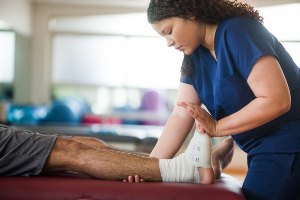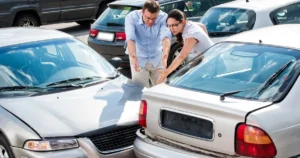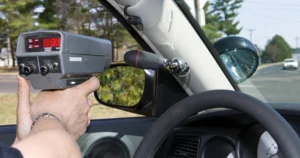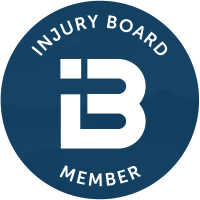 The pain in your leg is probably from a leg injury, such as a broken bone, sprained or torn ligament, or even a blood clot. Pain and other leg injury symptoms can make everyday life much more difficult, so you should seek treatment right away.
The pain in your leg is probably from a leg injury, such as a broken bone, sprained or torn ligament, or even a blood clot. Pain and other leg injury symptoms can make everyday life much more difficult, so you should seek treatment right away.
Below, our South Bend auto accident attorneys address the common causes of leg pain after a crash, along with other symptoms and treatment options.
If you were injured in a crash caused by the other driver’s negligent actions, our South Bend car accident lawyers are prepared to help you seek compensation. Our firm does not charge any upfront fees and only gets paid if we win your case and you receive compensation.
Schedule a FREE case review: (574) 444-0741.
How Can a Car Accident Cause a Leg Injury?
Most auto accident leg injuries are a result of direct, blunt force trauma. This means your leg got hit by something, resulting in a broken bone or soft-tissue damage. For instance, in a side-impact crash, the driver’s side door could crumple inward and injure your left knee. Your leg could also hit the dashboard and suffer an injury.
Crash victims often tense up in the moments before a collision. When you combine this with blunt force trauma, there is a higher potential for an injury.
Some auto collision leg injuries are caused by the leg twisting during the collision. For instance, if your leg gets stuck under the dashboard and you tense up, your knee could twist. This could tear a ligament in your knee.
High-speed collisions, head-on collisions and any other crash that causes severe damage to the victim’s vehicle may be more likely to cause a leg injury.
Including a Leg Injury in a Car Crash Claim
One of the most important things any injury victim can do, whether he or she was injured in a crash or another type of incident, is go to the hospital right away. If you get treatment soon after the collision, the insurance company is going to have a much more difficult time disputing that your injuries happened in the crash.
Another critical step is continuing your medical care and reporting new symptoms that arise. A record of consistent treatment and details about new symptoms that are consistent with your diagnosis help to strengthen a claim.
Leg injuries often require victims to limit physical activity to help their injuries heal. If you do not follow these instructions, the insurance company could argue you are failing to mitigate your damages. They may accuse you of trying to artificially inflate the value of your claim by taking steps to prolong your recovery.
Our experienced lawyers help crash victims properly document their injuries and take other steps to help them pursue full compensation for their damages.
Common Reasons for Leg Pain Following a Crash
You can divide leg injuries into five categories based on the area in the leg that was affected:
Upper Leg Injuries
Your upper legs consist of thighs, hamstrings, quadriceps and adductors, all of which could suffer damage in a car accident. One example of an upper leg injury is a broken femur.
The femur is the strongest bone in your body that will not break unless tremendous force is applied. This is also why these injuries take a long time to heal.
Lower Leg Injuries
These are injuries to the structures between your knees and ankles, such as a fractured tibia (shin bone) or fibula. These bones could break if one of your legs gets crushed during the collision.
Another type of lower leg injury is an Achilles tendon sprain or tear. This could be caused by your ankle getting stuck under something and pulled with more force than the tendon can bear.
Knee Injuries
Your knees are two of the most important and stressed joints in your body. They consist of ligaments, cartilage, tendons, menisci and a cap called a patella.
Blunt force trauma could cause a broken kneecap. Twisting of the knee could also tear or sprain the ligaments and other soft tissues in your knee. These are painful injuries that could limit your mobility.
Another type of knee injury is a dislocated knee. This happens when a bone pops out of place. Dislocations and fractures often damage the surrounding soft tissues.
Ankle Injuries
During a crash, you could twist or break your ankle. This could be caused by your ankle getting stuck under something and twisted. You could tear or sprain the medial or lateral ligaments that help stabilize your ankle.
Foot Injuries
Your foot has numerous bones, muscles and joints, along with dozens of tendons and ligaments. Any injury to the foot could make it difficult for victims to walk. They may have to use a cane or walker to help them maintain their balance.
Leg Injury Symptoms
Pain in a body part is one of the most common indicators of an injury. For instance, if you have pain in your right or left leg, it could mean that you have fractured bones or soft tissue damage.
Victims of car crashes could experience a wide range of leg pain, such as:
- Sharp pain
- Throbbing pain
- Burning pain
Some of the other symptoms that victims may experience include:
- Instability could indicate a torn MCL (medial collateral ligament), slipped disc or fractured bone
- Inability to stand
- Inability to bend your knee
- Limited range of motion in your leg
- Deformity or misalignment
- Swelling and bruising could mean that you have tissue damage or inflammation
- Numbness or pins and needles sensations could signify nerve damage
- Clicking or popping noise when moving your joints
- Stiffness due to joint damage
- Bruising in the injured area
- And more
What Treatment Options Do I Have for Leg Pain?
Treatment for leg pain can vary depending on the type of injury. Victims should seek medical treatment right away. If you wait to obtain treatment, you are risking a longer-term injury. The damage can worsen and become harder to treat.
The most serious injuries are likely to need surgery to fully heal, or at least heal as much as possible. For instance, a complex fracture may require doctors to insert screws, pins or plates to help the bones stay together while they heal.
Many leg injury victims are going to need physical therapy to help regain mobility and strength in the affected leg. Without physical therapy, victims risk further injury to the affected area.
Some injured victims may benefit from heat or ice to help reduce inflammation and promote healing. Doctors may also prescribe medication, including over-the-counter pain medication.
Doctors are likely to recommend limited physical activity to prevent further injury to the leg.
Continued treatment is vital, as it connects the injury to the crash and allows doctors to manage complications that may arise, such as blood clots. These can be fatal if they are not treated right away.
Call Pfeifer, Morgan & Stesiak After a Car Crash Injury
Navigating the complicated legal system on your own can be challenging. However, you do not have to attempt to understand the legal process alone. Our knowledgeable attorneys are ready to guide you through it.
We have decades of getting results for our clients without any upfront fees. We only get paid if you receive compensation.
Call our office today to discuss possible legal options: (574) 444-0741.













